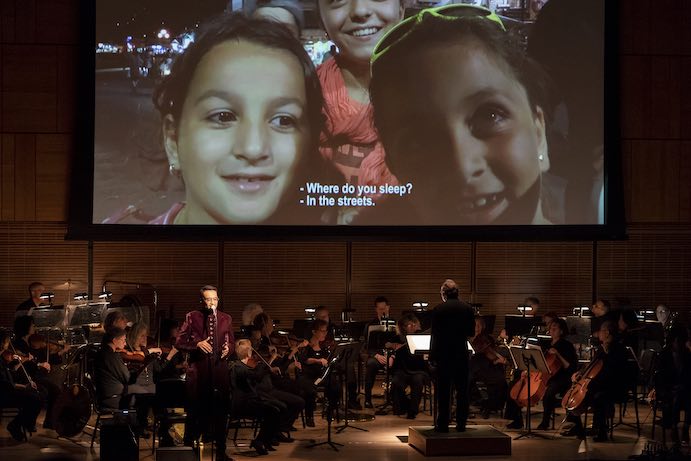The American Composers Orchestra concert on April 11, 2019 at the “medium-sized” Carnegie Hall, Zankel, was a social affair with several looks back and one look forward towards a hard, glaring series of truths. On the program was Morton Feldman’s Turfan Fragments, Gloria Coates’ Symphony No. 1 “Music on Open Strings,” and finally, the highlight of the evening, the New York premiere of Du Yun’s Where We Lost Our Shadows, commissioned by ACO, Carnegie Hall, The Kennedy Center, Southbank Centre, and Cal Performances. The audience was an eager and educated one: a keen eye could spot Otto Luening’s widow smack dab in the middle of the audience, David Hertzberg’s indelible spectacles peering down from the balcony, and even Morton Feldman’s own contemporary doppelgänger Frank J. Oteri.
Inspired by pieces of knotted carpet dating from the third and sixth centuries that were found during a series of archaeological expeditions to East Turkestan in the early 20th century, Turfan Fragments begins as a translucent cloud of pitches of all types, gradually becoming opaque, steadily increasing in kinetic energy as they struggle towards each other. Harmonics in the basses were performed so delicately and yet so full of tone that they lent pale peach colors to the darker pigment of oboe solos, letting the stark viola and flute lines stand out with drama and poise. Momentum is not the object here; the collections of notes build up on each other and ruminate amongst themselves on the palette of one’s mind, akin to the way words of poetry linger and mix upon the tongue when spoken. Like those fragments of knotted carpets, this work’s delectable experience comes not from its overall structure but from the way a new pattern of tones and timbres is played with every few bars. It’s this small aural fragment that captures our attention; a few moments in time given distinct importance before we are allowed to move forward to the next few moments of texture and color in this patchwork piece.
Gloria Coates and Edward Yim–Photo by Jennifer Talyor
Gloria Coates, now in her 80s, graciously introduced her first symphony on stage before the performance. Unfortunately, it was at times difficult to concentrate on her words above the brass warmups backstage that bled in through an open stage door. Her work is a four-movement, twenty-minute piece quite literally for open strings, all instruments in heavy scordatura: tuned to five new pitches that are gradually yanked back to their original conditioning over the course of the work. The first movement begins morose and plodding, colored by that special, nearly muddy sonic quality that comes from strings being stretched or relaxed beyond what they’re used to. Tapping on instruments and rhythms that had a consistency like breathing mixed with the whine of long tones in the violin, the sting of cello slap pizz. Wide vibrato and cello power chords colored the middle movements while the fourth movement’s steadily growing cacophony of siren-like glissandi stretched the drama of this work to its pinnacle.
Du Yun’s Where We Lost Our Shadows, created in conjunction with filmmaker Khaled Jarrar, felt less like a piece for orchestra and vocal soloists with visual accompaniment and more like a grand concerto for audience immersion, video, orchestra, percussion, and two voices with remarkably different skill sets. With its highly emotional, deep and truthful subject matter, the work welcomes its viewer-listeners to confront for themselves the contemporary experience of refugees. The piece’s 25 minutes are filled with the loud, forceful, and spectacular percussion solos of Shayna Dunkelman; ragas that discuss forms of water (remember that bodies of water present some of the most difficult barriers for human migration), sung by the radically talented Ali Sethi; and a setting of the poem “Pillow” by Palestinian poet Ghassan Zaqtan, sung by Helga Davis in her frightfully gorgeous ochre tones. The film’s scenes stand alone like an intermittent series of cadenzas tracing a family through the harrowing experience of crossing an unforgiving desert at night by flashlight and the painful optimism of children eager to talk about the places they know their family is journeying towards.
Du Yun and Khaled Jarrar’s Where We Lost Our Shadows performed by the American Composers Orchestra–Photo by Jennifer Taylor
A clip of pomegranate seeds is a recurring theme; first, they appear on screen so blurred that one might instead make out a flurrying of bright red birds scuttling across an azure sky. At the end of the piece, they appear in full focus, surely hinting at something difficult and biblical, followed by soloists and orchestra members reaching down to grab large cardboard circles covered in gold foil and holding them up to the light: the audience, now, is subject to the uncomfortable glare of flashlights in a darkened space. We’ve been made to feel a spectrum of emotions that cannot come from news clips or click-bait headlines; they can only come from immersion.

